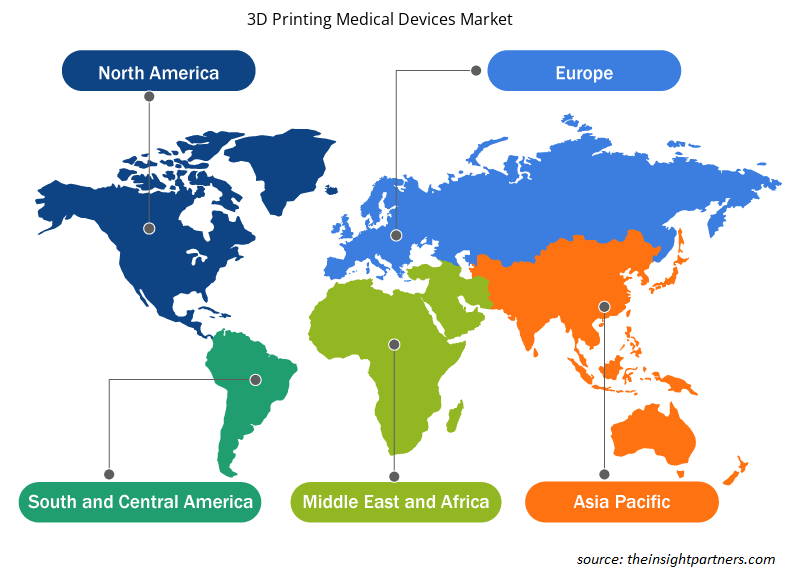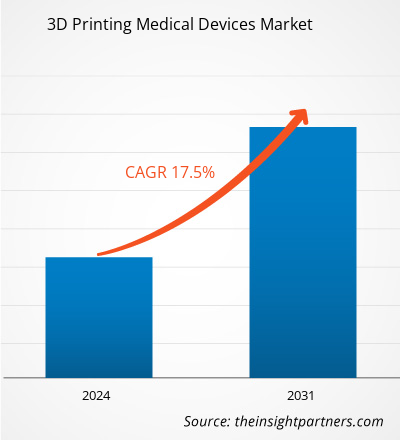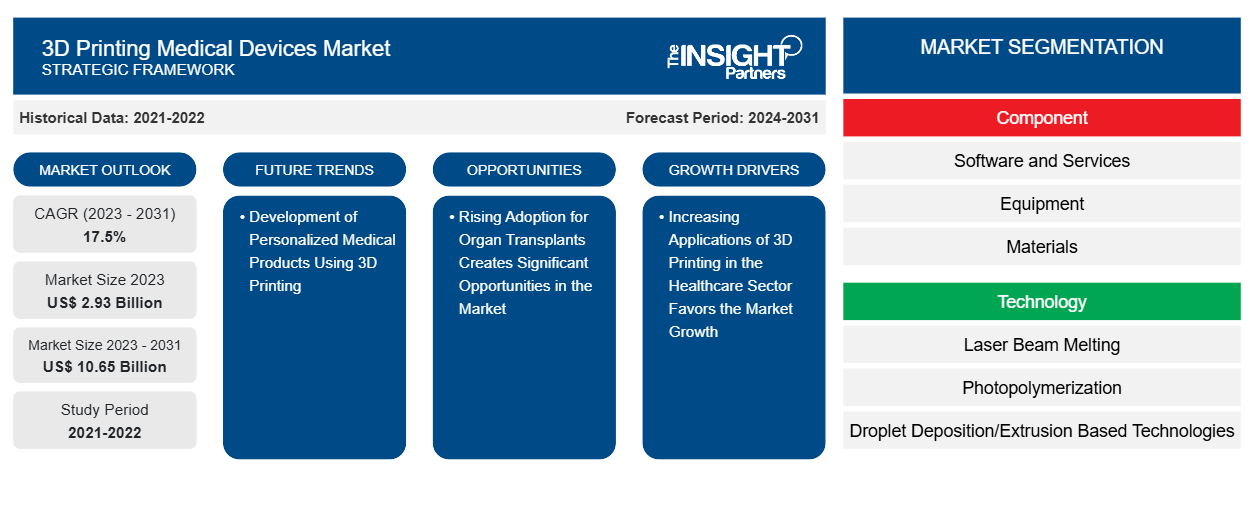3D 프린팅 의료 기기 시장 규모는 2023년 29억 3천만 달러에서 2031년 106억 5천만 달러로 성장할 것으로 예상됩니다. 이 시장은 2023~2031년 동안 17.5%의 CAGR을 기록할 것으로 예상됩니다. 3D 프린팅을 사용한 개인화된 의료 제품 개발은 시장의 주요 트렌드로 남을 가능성이 큽니다.
3D 프린팅 의료 기기 시장 분석
3D 프린팅으로 만든 의료 기기 시장은 잘 확립되어 있습니다. 의료 분야에서 3D 프린팅 사용이 증가함에 따라 채택이 촉진되고 시장의 전반적인 확장에 기여합니다. 장기 이식 수술의 증가로 3D 프린팅 의료 기기에 대한 수요가 증가했습니다. 이러한 강화 요소는 시장 전체의 확장에 영향을 미칩니다. 머지않아 3D 프린팅을 통해 맞춤형 의료 제품을 만드는 것은 시장 확장에 대한 수익성 있는 전망을 제시할 것입니다.
3D 프린팅 의료 기기 시장 개요
최근 수십 년 동안, 이식형 의료 기기는 정확도와 최적의 재료 활용 능력으로 인해 3D 프린팅 기술의 사용이 증가했습니다. 외상학, 정형외과 수술 및 치과 분야는 이러한 기구에서 가장 많은 이익을 얻을 수 있습니다. 아무리 복잡하더라도 3D 프린팅 기술을 사용하면 처리 문제 없이 모든 모양의 이식형 의료 기기를 생산할 수 있습니다. 복잡한 이식형 의료 기기를 만들고 생산하는 것과 관련된 문제를 해결할 수 있습니다. 개인화되고 맞춤화된 이식형 의료 기기도 3D 프린팅 공정을 사용하여 만들 수 있습니다.
전 세계적으로 두 번째로 흔한 치과 질환은 충치입니다. 성별에 따라 약간의 차이만 있을 뿐, 치열 교정 문제는 두 성별 모두에서 흔합니다. 맞춤형 제품의 잠재력은 의료 및 치과 응용 분야에서 3D 프린팅의 발전, 소규모 생산의 비용 절감, 환자 이미지 데이터의 공유 및 처리의 용이성, 교육의 개선을 주도하고 있습니다. 치주과 및 치근관 치료의 전문 분야에서의 응용 분야에 대한 출판물은 제한적입니다. 3D 프린팅 기술은 주로 구강 수술 및 보철학 응용 분야에 초점을 맞추고 그 다음으로 치열 교정학에 초점을 맞춥니다. 외과의는 3D 프린팅 기술의 임상적 사용으로 인해 고급 이미지 처리가 가능한 사실적인 신체 해부학 모델에서 수술을 수행할 수 있습니다.
귀하의 요구 사항에 맞게 이 보고서를 사용자 정의하세요
이 보고서의 일부 또는 국가 수준 분석, Excel 데이터 팩을 포함하여 모든 보고서에 대한 사용자 정의를 무료로 받을 수 있으며 신생 기업 및 대학을 위한 훌륭한 혜택과 할인 혜택을 이용할 수 있습니다.
-
이 보고서의 주요 시장 동향을 알아보세요.이 무료 샘플에는 시장 동향부터 추정 및 예측까지 다양한 데이터 분석이 포함됩니다.
3D 프린팅 의료 기기 시장 동인 및 기회
의료 분야에서 3D 프린팅의 적용이 늘어나면서 시장 성장이 촉진될 것입니다.
환자의 특정 해부학적 구조에 해당하는 복잡한 기하학적 구조나 특징을 가진 광범위한 의료 기기가 3D 프린터를 사용하여 생산됩니다. 표준 설계는 몇 가지 기기를 인쇄한 후 동일한 기기의 수많은 복제품을 만듭니다. 환자별 영상 데이터는 환자 맞춤 또는 환자별 기기라고도 하는 추가 기기를 개발하는 데 사용됩니다. 인쇄물의 용도와 프린터의 사용 편의성은 3D 인쇄 기술을 선택하는 데 고려해야 할 두 가지 사항입니다. 3D 인쇄 의료 기기에 가장 널리 사용되는 기술은 파우더 베드 퓨전입니다. 이 방법은 의료 기기에 사용되는 나일론과 티타늄을 포함한 다양한 소재와 함께 작동합니다. CT 및 MRI 스캔을 사용하여 3D 인쇄는 각 환자에게 맞는 촉각적 참조 모델을 저렴하고 쉽게 만들 수 있습니다. 이러한 모델은 다른 관점을 제공함으로써 의사가 수술을 더 잘 준비하도록 돕고 수술실에서 실제 시술에 필요한 시간과 비용을 크게 줄입니다. 환자는 만족도 증가, 불안 감소, 회복 가속화를 통해 이를 통해 이익을 얻을 수 있습니다.
또한, 의학 분야에서 3D 프린팅을 위한 새로운 생체적합성 소재를 도입하면 신선한 수술 도구와 방법을 만드는 데 도움이 되며, 이는 모두 환자의 수술 경험을 향상시키는 데 목적이 있습니다. 멸균 고정 트레이, 윤곽 템플릿, 임플란트 크기 조정 모델은 3D 프린팅을 통해 생산할 수 있는 도구 중 일부입니다. 이를 사용하여 초기 절단 전에 수술실에서 임플란트 크기를 조정하여 외과의의 시간을 절약하고 복잡한 시술 중 정확성을 높일 수 있습니다.
장기 이식에 대한 수용 증가로 시장에서 상당한 기회가 창출됨
장기 이식에서 3D 프린팅 기술을 사용하는 것이 점점 더 유리해지고 있습니다. 3D 바이오 프린터는 품질 요구 사항과 기대를 충족하기 위해 수많은 반복과 개선을 거쳤습니다. 그 결과, 3D 프린터를 만들고 개발하는 것은 더 광범위한 응용 분야와 함께 끊임없이 진화하고 있습니다. 의료 기기 생산을 가속화함으로써 3D 프린터는 생명을 구하는 데 도움이 됩니다. 장기 기증자 부족과 수혜자 장기 거부 문제를 해결하는 데 도움이 됩니다. 또한 의료 전문가가 많은 수의 환자를 신속하게 치료할 수 있습니다. 혈액, 산소 및 필수 영양소를 제공하는 쉽게 접근할 수 있는 환경이 없으면 장기가 생존할 수 없습니다. 3D 프린팅 기술을 사용하여 이식된 장기를 위한 안전한 환경을 만들 수 있습니다. 거세하는 대신 바이오 프린팅되기 때문에 3D 프린터는 의료 분야에서 장기 교체에 상당한 영향을 미칩니다. 이를 통해 적합한 기증자를 찾는 데 소요되는 시간이 줄어듭니다. 따라서 그 결과는 특히 삶의 질과 관련하여 사회에 상당한 긍정적인 영향을 미칠 것으로 예상됩니다. 3D 생체 프린팅의 유망한 활용 사례로는 인공 조직과 장기를 만드는 것이 있으며, 이는 재생 의학 분야를 완전히 변화시킬 수 있습니다.
3D 프린팅 의료 기기 시장 보고서 세분화 분석
3D 프린팅 의료 기기 시장 분석에 기여한 주요 세그먼트는 구성 요소, 기술, 응용 프로그램 및 최종 사용자입니다.
- 구성 요소를 기준으로 3D 프린팅 의료 기기 시장은 소프트웨어 및 서비스, 장비 및 재료로 구분됩니다. 장비 부문은 2023년에 가장 큰 시장 점유율을 차지했습니다.
- 기술별로 시장은 레이저 빔 용융, 광중합, 물방울 증착/압출 기반 기술, 전자 빔 용융으로 분류됩니다. 광중합 세그먼트는 2023년에 시장에서 가장 큰 점유율을 차지했습니다.
- 응용 프로그램별로 시장은 맞춤형 보철물 및 임플란트, 조직 공학 제품, 수술 가이드, 수술 도구, 착용형 의료 기기, 보청기, 표준 보철물 및 임플란트, 기타로 세분화됩니다. 맞춤형 보철물 및 임플란트 부문은 2023년에 시장에서 가장 큰 점유율을 차지했습니다.
- 최종 사용자별로 시장은 병원 및 수술 센터, 치과 및 정형외과 센터, 의료 기기 회사, 학술 및 연구 기관, 제약 및 생명공학 회사 등으로 세분화됩니다. 병원 및 수술 센터 부문은 2023년에 시장에서 가장 큰 점유율을 차지했습니다.
지역별 3D 프린팅 의료 기기 시장 점유율 분석
3D 프린팅 의료 기기 시장 보고서의 지리적 범위는 주로 북미, 아시아 태평양, 유럽, 중동 및 아프리카, 남미 및 중부 아메리카의 5개 지역으로 나뉩니다.
북미는 미국, 캐나다, 멕시코의 세 나라로 구성되어 있습니다. 미국은 3D 프린팅 의료 기기의 가장 큰 시장이며, 그 다음은 캐나다와 멕시코입니다. 미국에서만 매년 약 200,000건의 절단이 이루어지고, 보철물 교체 또는 변형은 비용이 많이 들고 시간이 많이 소요될 수 있으며, 가격은 5,000달러에서 50,000달러까지 다양합니다. 보철물은 이처럼 개인화된 장치이므로 각각 주문 제작하거나 착용자의 사양에 맞게 맞춤 제작해야 합니다. 요즘에는 AM 기술이 자주 사용되어 각 환자의 해부학적 구조에 맞게 맞춤 제작된 보철물 구성품을 만들어 완벽한 핏을 보장합니다. AM은 다양한 소재로 복잡한 기하학적 모양을 만들 수 있는 능력 때문에 보철물이 환자와 접촉하는 곳에 사용됩니다. AM 기술은 편안한 보철 다리 연결부에서 암 환자를 위한 복잡하고 고도로 맞춤화된 얼굴 보철물에 이르기까지 광범위한 제품을 개발했습니다.
미국의 의료 연구소이자 연구 기업인 Organovo는 장기의 시험관 내 연구와 특정 질병에 대한 약물 개발을 돕기 위해 장 및 간 조직을 인쇄하는 실험을 했습니다. 이 회사는 2018년 5월에 1형 티로신혈증 프로그램에서 간 조직의 기능에 대한 임상 전 데이터를 발표했습니다. 티로신은 효소 결핍으로 인해 신체가 대사할 수 없는 아미노산입니다.
3D 프린팅 의료 기기 시장 지역 통찰력
Insight Partners의 분석가들은 예측 기간 동안 3D 프린팅 의료 기기 시장에 영향을 미치는 지역적 추세와 요인을 철저히 설명했습니다. 이 섹션에서는 북미, 유럽, 아시아 태평양, 중동 및 아프리카, 남미 및 중미의 3D 프린팅 의료 기기 시장 세그먼트와 지리적 분포도 논의합니다.

- 3D 프린팅 의료 기기 시장에 대한 지역별 특정 데이터 얻기
3D 프린팅 의료 기기 시장 보고서 범위
| 보고서 속성 | 세부 |
|---|---|
| 2023년 시장 규모 | 29억 3천만 달러 |
| 2031년까지 시장 규모 | 106억 5천만 달러 |
| 글로벌 CAGR (2023-2031) | 17.5% |
| 역사적 데이터 | 2021-2022 |
| 예측 기간 | 2024-2031 |
| 다루는 세그먼트 |
구성 요소별로
|
| 포함된 지역 및 국가 |
북아메리카
|
| 시장 선도 기업 및 주요 회사 프로필 |
|
3D 프린팅 의료 기기 시장 참여자 밀도: 비즈니스 역학에 미치는 영향 이해
3D 프린팅 의료 기기 시장은 소비자 선호도의 변화, 기술 발전, 제품의 이점에 대한 인식 증가와 같은 요인으로 인해 최종 사용자 수요가 증가함에 따라 빠르게 성장하고 있습니다. 수요가 증가함에 따라 기업은 제품을 확장하고, 소비자의 요구를 충족하기 위해 혁신하고, 새로운 트렌드를 활용하여 시장 성장을 더욱 촉진하고 있습니다.
시장 참여자 밀도는 특정 시장이나 산업 내에서 운영되는 회사나 기업의 분포를 말합니다. 주어진 시장 공간에 얼마나 많은 경쟁자(시장 참여자)가 존재하는지 그 규모나 총 시장 가치에 비해 나타냅니다.
3D 프린팅 의료 기기 시장에서 운영되는 주요 회사는 다음과 같습니다.
- EOS GmbH 전기 광학 시스템
- 레니쇼 PLC
- 스트라타시스 유한회사
- 3D 시스템즈 주식회사
- 엔비전테크 주식회사
- 컨셉트 레이저 Gmbh (제너럴 일렉트릭)
면책 조항 : 위에 나열된 회사는 어떤 특별한 순서에 따라 순위가 매겨지지 않았습니다.

- 3D 프린팅 의료 기기 시장 주요 주요 업체 개요를 알아보세요
3D 프린팅 의료 기기 시장 뉴스 및 최근 개발
3D 프린팅 의료 기기 시장은 1차 및 2차 연구 이후의 정성적, 정량적 데이터를 수집하여 평가합니다. 여기에는 중요한 기업 간행물, 협회 데이터 및 데이터베이스가 포함됩니다. 3D 프린팅 의료 기기 시장의 몇 가지 개발 사항은 다음과 같습니다.
- Align Technology, Inc.는 투명 교정기 Invisalign 시스템, iTero 구강 스캐너, 디지털 교정 및 보철 치과용 exocadCAD/CAM 소프트웨어를 설계, 제조 및 판매하는 선도적인 글로벌 의료 기기 회사로, 폴리머 적층 제조를 위한 직접 3D 인쇄 솔루션의 선구자인 비공개 회사 Cubicure GmbH를 인수했다고 발표했습니다. 이 회사는 새로운 3D 인쇄 솔루션을 위한 혁신적인 소재, 장비 및 프로세스를 개발, 생산 및 유통합니다. (출처: Align Technology, Inc., 보도자료, 2024년 1월)
3D 프린팅 의료 기기 시장 보고서 범위 및 제공물
"3D 프린팅 의료 기기 시장 규모 및 예측(2021-2031)" 보고서는 아래 영역을 포괄하는 시장에 대한 자세한 분석을 제공합니다.
- 범위에 포함된 모든 주요 시장 세그먼트에 대한 글로벌, 지역 및 국가 수준의 3D 프린팅 의료 기기 시장 규모 및 예측
- 3D 프린팅 의료 기기 시장 동향 및 동인, 제약 및 주요 기회와 같은 시장 역학
- 자세한 PEST/포터의 5가지 힘과 SWOT 분석
- 주요 시장 동향, 글로벌 및 지역적 프레임워크, 주요 업체, 규정, 최근 시장 개발 사항을 다루는 3D 프린팅 의료 기기 시장 분석입니다.
- 3D 프린팅 의료 기기 시장의 시장 집중도, 히트맵 분석, 유명 업체 및 최근 개발 사항을 다루는 산업 환경 및 경쟁 분석
- 자세한 회사 프로필
- 과거 분석(2년), 기준 연도, CAGR을 포함한 예측(7년)
- PEST 및 SWOT 분석
- 시장 규모 가치/거래량 - 글로벌, 지역, 국가
- 산업 및 경쟁 환경
- Excel 데이터세트
최근 보고서
관련 보고서
사용 후기
구매 이유
- 정보에 기반한 의사 결정
- 시장 역학 이해
- 경쟁 분석
- 고객 인사이트
- 시장 예측
- 위험 완화
- 전략 기획
- 투자 타당성 분석
- 신흥 시장 파악
- 마케팅 전략 강화
- 운영 효율성 향상
- 규제 동향에 발맞춰 대응























 무료 샘플 받기 - 3D 프린팅 의료기기 시장
무료 샘플 받기 - 3D 프린팅 의료기기 시장